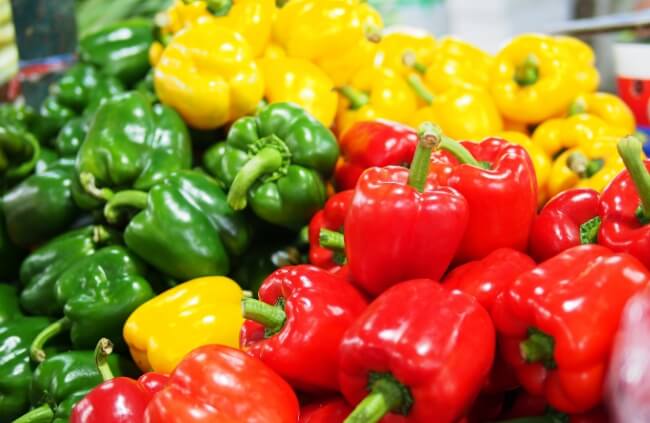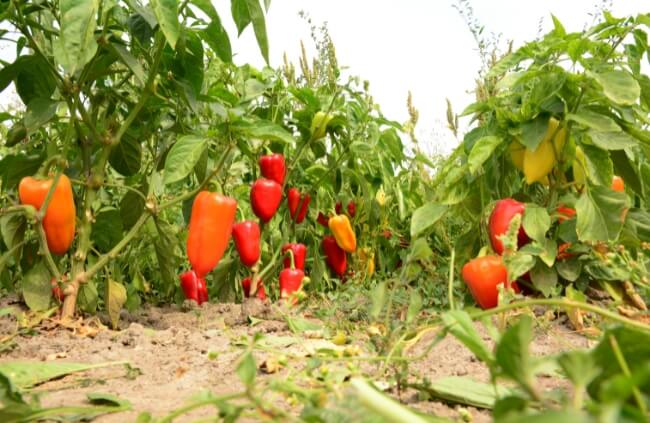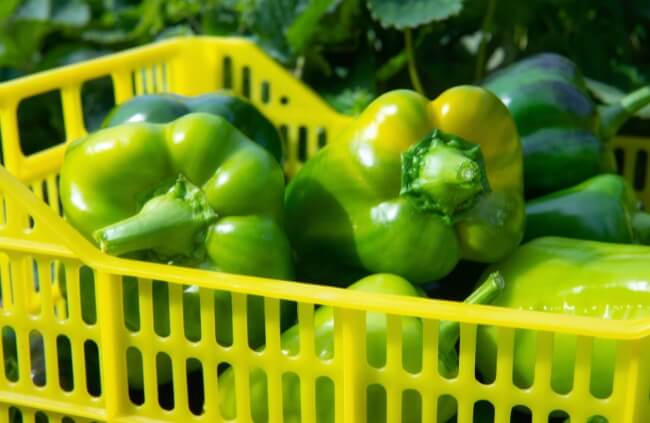Capsicums are one of the easiest plants to grow in an Aussie garden. A versatile, colourful vegetable with a sweet flavour and rich in Vitamin C. Delicious to eat raw or cooked, capsicums are a favourite ingredient for cooks and are used extensively in a wide range of cuisines.
Growing capsicum at home will keep you well stocked with fresh and tasty fruit. They love warm weather and can be grown in a veggie patch or pots. Capsicum plants thrive during Australian summers and are a must-have plant in your garden!
This gardening guide outlines how and when to plant capsicum, how to grow capsicum, when to harvest the fruit and how to deal with pests.
More...
Botanical name: | Capsicum annuum |
|---|---|
Botanical family: | Solanaceae (Nightshade) |
Introducing Capsicum

Capsicum plants are a sturdy, compact bush that grows to a height of around 50 cm tall. It produces colourful, mild peppers for several months. Like tomatoes, the plant belongs to the Solanaceae family.
Capsicum annuum is known by the common name capsicum in Australia, New Zealand and many parts of Asia. In other parts of the world, it is more commonly referred to as bell pepper, pepper, or sweet pepper.
All capsicums, start off green, then ripen into another colour as they mature. This is why green capsicums are generally cheaper in your grocery store, as they take less vine time to mature. Capsicums grow in lots of different colours including black, yellow, orange and red.
They are typically large bell-shaped fruits with thick walls. Capsicum plants are a good source of Vitamin C and A. Like tomatoes they are classified as botanical fruits but culinary vegetables.
Sweet peppers don’t contain any capsaicin. As the only member of the genus Capsicum which doesn’t produce the capsaicin, this helps distinguish capsicum from chillies. Capsicum peppers are sweet rather than eye-wateringly hot!
In frost-free areas of Australia, capsicums are perennials but are more commonly and successfully grown as annuals. Bell peppers are not frost tolerant.
Common Types of Capsicum Available in Australia
If you are interested in growing capsicum at home, there are several capsicum varieties readily available in Australian nurseries and garden centres.
Some of the most common varieties you might consider include:
- Giant Bell (California Wonder) – A large, bell-shaped glossy fruit that turns from dark green to a deep red as they mature. The most popular bell pepper in Australia.
- Colour Salad Collection – A mix of different capsicum shapes, sizes, and colours. As the name suggests, these are great for salads and often used in the Mediterranean and Asian cuisines.
- Sweet Banana – A thick fleshed yellow fruit. The elongated fruit, approximately 15 cm in size, matures to a red colour. Great for stuffing or grilling on the BBQ.
- Yolo Wonder – A green capsicum that ripens to scarlet red. Approximately 10 cm in size. An improved strain of California Wonder.
- Capsicum (Sweet Chocolate) – Deep chocolate colour skin and burgundy inside
Growing Capsicum in Australia
They will grow in a wide range of soils. Capsicum plants are relatively hardy plans, with deep root systems and are adaptable to both heavy and light soils. It does best in rich, fertile, and well-drained soil.
Use lots of organic matter in your soil when growing capsicum. For best results prepare the soil a couple of weeks prior to planting with some well-rotted manure and added fertiliser.
To successfully grow bell peppers in a container pot we would suggest using a high-quality premium potting mix or good quality garden soil and plenty of compost.


Get Your Free Guide:
Master Growing Australian Natives eBook
A Must Have Complete Guide for Every Australian Garden
Get Your Free Guide:
Master Growing Australian Natives eBook
A Must Have Complete Guide for Every Australian Garden
Growing Capsicum from Seeds

How to grow capsicum from seed? The good news is that it is pretty easy! The best time to sow capsicum seeds depends on where you are based in Australia. Capsicums are warm-season plants and in tropical and subtropical parts of Australia can be grown almost all year round.
In temperate areas of Australia, it is best to sow capsicum seeds from August to December. In colder climates sow capsicum seeds in September, October, or November.
Growing capsicum seeds and raising seedlings is best done in plastic punnets. Propagate seeds into individual cells of the seed tray or punnet. Sow the capsicum seeds no more than 1 cm deep.
Keep them indoors until the capsicum seedlings begin to emerge. They put them in small pots outside in a sheltered, sunny spot until they are about 15-20 cm tall. They will then be ready to transplant to the garden when daytime temperatures regularly exceed 20°C.
You can sow seeds directly in your garden bed but because of the short growing season in many parts of Australia, it is best to raise seedlings in a warm part of the garden, before then transplanting them to the veggie patch when the soil is warm enough.
When planting capsicum seedlings in the garden, space the plants about 40-50 cm apart. Don’t overcrowd them as they will become drawn and leggy. Give them space to breathe so the sun can warm the soil and there is good free air movement.
Growing Capsicum in Pots
Sweet peppers can be successfully grown in container pots. It is worth noting though that while capsicum can do well in large pots, they typically grow better when planted in the ground. If you have the space our advice is to grow capsicum in your veggie patch.
If growing capsicum in pots, you will need a relatively large container. A pot between 40-50 cm tall and deep will allow you to grow a good-sized capsicum plant. This will give your capsicum plant plenty of root space and ensure roots are subject to less temperature and moisture fluctuation.
Grow only one bell pepper plant per pot. This means the plant won’t be competing for nutrients or sunlight.
Where to Position Capsicum in Your Garden

The best spot for capsicum in your garden is a sunny, sheltered position. Make sure it is protected from the wind and in a nice hot area of your garden that gets full sun.
During hot Australian summers, capsicum may need some protection from the harsh direct sun on hot afternoons. To avoid burning, ideally find a spot that gets some shade after lunch.
Where possible try and group plants in your veggie patch which grow to similar heights and mature about the same time as your capsicum. This will ensure that each plant is given a fair share of sunlight and isn’t overshadowed.
Also, consider the extended harvest period of your capsicum. Capsicum plants will continue occupying space in your veggie patch for 2-3 months after your first picking.
How to Care for Capsicum
Capsicum plants need regular watering. After transplanting and as the plant matures you should water 2-3 times a week. After the capsicum is established, which is usually about a month, you can cut back to watering about once a week. This will encourage stronger root development. If you are growing capsicum in a pot, you will need to water more regularly.
Make sure to water your capsicum plant regularly and consistently. Under and overwatering the plant can make the fruit probe blossom end rot. Don’t overfeed the capsicum plants, especially with a high-nitrogen fertiliser, in the early stages of their development as you’ll get a lot of soft foliage growth, at the expense of fruit.
When the plants do begin to flower, you can add some liquid fertiliser every couple of weeks while the plants are bearing fruit. Anything designed for tomatoes will work well for growing capsicum too.
It can also be beneficial to also add more organic material occasionally to the soil to help with soil-borne disease resistance. If you are growing large capsicums or the plant is exposed to wind, then you may need to provide some support. Stake close to the plant and tie the main stems with garden twine.
When to Harvest Capsicum

Capsicums are typically a late summer vegetable. You can harvest the capsicum fruit whenever you want and there is no need to wait until the fruit has grown to full size. Alternatively, you can harvest them later as the fruit ripens and changes colour. This takes about 10-12 weeks.
The longer you wait to harvest capsicum the sweeter they will taste. Regular harvesting of the fruit can stimulate more flowering and fruiting. The more fruit you remove, the more capsicum you will produce. Capsicum plants are generally productive for many months.
To pick the fruit, simply twist until it snaps off. Alternatively cut off the fruit, which will ensure you don’t damage the plant.
Capsicum Plant Pests and Diseases
Capsicums are relatively untroubled by pests and disease. However, when growing capsicums there can be occasional issues with fruit flies, blossom end rot and root-knot nematodes.
Blossom End Rot
Blossom end rot typically occurs due to inconsistent watering, resulting in a sunken and discoloured spot on the capsicum fruit’s end. This can lead to premature rotting.
Just make sure to water regularly and consistently, adapting to weather conditions, and you shouldn’t have a problem. Mulching your veggie patch will also help.
Fruit flies
Fruit flies can also impact capsicum. They burrow through the fruit and lay eggs in the skin, causing them to rot. The chance of fruit flies can be mitigated by not letting the capsicum over ripen or leaving them on the plant to rot. Another option is to cover the plant in a fruit bag.
Root-Knot Nematodes
Capsicum can be susceptible to root-knot nematodes. Also known as eelworms, these tiny soil-based pests breed in and damage the feeder roots. Root-knot nematodes will impact the capsicum plant's growth and reduce the quality and quantity of fruit.
You can reduce the risk of root-knot nematodes in your garden soil via good crop rotation, making sure not to leave mature plants in your veggie patch too long. It also helps to keep the garden weed-free as they can also host eelworm.
Maintaining lots of organic matter in the soil will help encourage microorganisms that eat the nematode lava and make your capsicum less susceptible to infestation.
Frequently Asked Questions About Capsicums

How long does capsicum take to grow?
Capsicum plants need warm weather to grow and typically take about 3-4 months to fruit depending on the variety and climate. Seedlings transplanted in September will typically bear fruit around Christmas time and keep bearing fruit until early autumn.
If you live in tropical or subtropical areas of Australia, you could sow seeds every 8-10 weeks and have a continuous supply of bell peppers.
How much fruit does a capsicum plant produce?
How much fruit each plant produces will depend on the variety of sweet pepper planted and growing conditions. Five well-grown plants will be sufficient to keep an average family in good supply of capsicum.
Australia’s most popular capsicum, California Wonder, should produce approximately 6-8 peppers per plant. If you have any questions about growing capsicums, get in touch.
Now You Know How to Grow Capsicum
Capsicums are a popular veggie to grow in Australian gardens as they are quick to produce fruit and are relatively low maintenance. The sweet pepper is an easy plant to grow and care for if planted in a great sunny, sheltered position with good soil and watered regularly.
Harvest green or leave them to mature into their ripe colour. You can then enjoy them in a salad, stuffed and baked, stir-fried, in a casserole and more. Raw or cooked, the choices are endless! There you have it! That is everything you need to know to start growing capsicum in your garden.
Published on August 21, 2023 by Maisie Blevins
Last Updated on September 20, 2025





if i want to carry forward the capsican plant throught to next season in Adelaide, Hallett Cove. How far back should i prune the bush and when should it be done?
last year i was picking through to May. Plants are in wicking beds, 350mm deep of potting mix and compost then 150mm of scoria. at this point i have used 2 layers of shadecloth to seperate. Our local tennis club was replacing the screening on the fences. (unhealthy?) I was contemplating swaping to a geocloth, are these made of plastic or less harmfull.
Hi Harry,
Spring pruning is key to healthy capsicum plants, but don’t go too far. I know some gardeners that will cut right back by about a third, but I’ve always just pruned out the tips. When they get too big just replace them as they’re only short lived and will slow down on fruit production after year 4 or 5.
Pinch out new growing tips to encourage new bushy growth that will develop flowers and fruits, and give it a really good feed.
What you did last year sounds like it worked well for you, so stick with that, and don’t worry about the type of shade cloth you’re using. If you can make use of someone else’s trach, the tennis club’s screening sounds ideal. The only job it’s got to do is protect from sunlight, so if it does that without completely blocking light out, it’ll work just fine.
Sounds like you’ve got this under control mate. Good luck with the pruning.
Maisie Blevins